
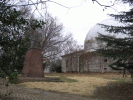


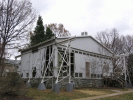
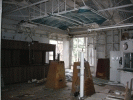

In early 2006, the process of demolishing buildings 6 and 7, former homes of the 7inch and 6inch transit circles was initiated. As there are many people, both current and former employees, who labored long nights on the 6inch bench it seemed appropriate to have a photo record of this process. (The 6" transit circle was in building 7 and the 7" transit circle was in building 6). For those unfamiliar with the reasons for removing buildings 6 and 7 ...
USNO desires for P-050 to be built to house the new Rubidium Fountain Clocks. This is vital for USNO to conduct it's mission in the future and required to support emerging DoD timing requirement. To support the construction of P-050, the Navy was required to demolish an equivalent amount of square footage to make way for the new construction. USNO agreed in the past to the partial demolition of Buildings 6 and 7 with the foundations remaining and marking of the spots of the building with a historical marker.
The 6" in the 20th Century defined the Celestial Reference Frame and the
stability of the piers of Building 7 gave a consistency for the axis of orientation
of the instrument and a primary factor in the northern part of the FK defined sky.
6 January 2006 Pictures







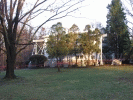


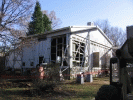
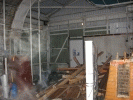

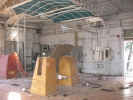
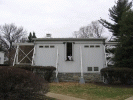

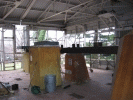
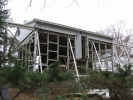
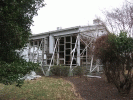

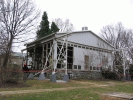
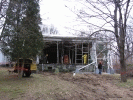
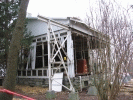
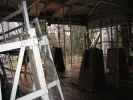


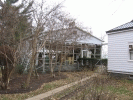
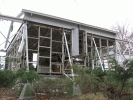

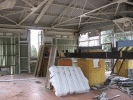

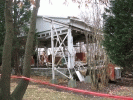

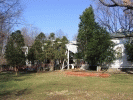

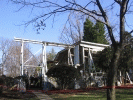



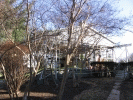

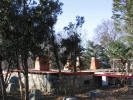
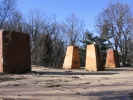

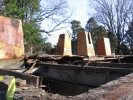




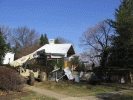
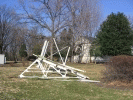
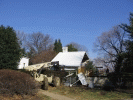


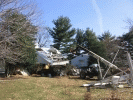
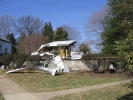


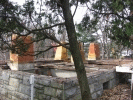
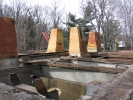
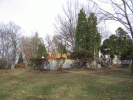

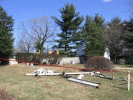



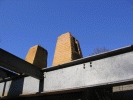
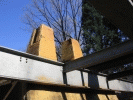
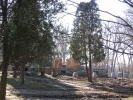
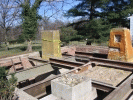

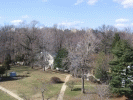


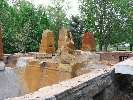


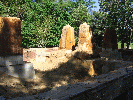
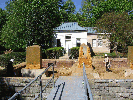
The two transit houses (building #6 and #7) and their mark houses were part of the original group of structures built when the USNO moved to the site in 1893. The design of the two transit houses was the same as the transit house (bldg #8) located on the west end of Building One. Buildings #6 and #7 were modified in the 1930’s to be lower and the roll-off roofs to open wider to improve the air circulation around the transit circles. I am not sure if any of the metal parts of the original buildings were used in the modification. It is likely a completely new frame work was required to support the significantly heavier roll-off roof. The walls (both inside and outside) and roofs for both buildings #6 and #7 were replaced in the late 1970’s or early 1980’s with materials that did not require painting.
The pier system for both buildings can be divided in three sections: the lower, middle, and upper. The lower section is a single large pier in the shape of a cross, with its top surface about 6 feet below ground level (about 10 feet below the floor level) and going down to bedrock. The middle section is made up of five piers, with their top surfaces being just below the floor level. The piers to the north and south were used to support the piers for the collimators/mark lenses. The piers to the east and west were used for the clocks. And the large central pier used to support the two piers of the transit circle. The upper section consisted of piers above the floor level to the north and south to support the collimators/mark lenses, and the two piers in the center of the room to support the transit circle.
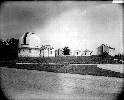
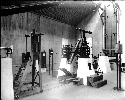




The Six-inch Transit Circle was the only telescope used in building #7. The original marble piers were replaced with brick piers in the early 1900’s, because they were believed to be the cause of large changes of the instrument’s azimuth. As the marble piers were being removed, pieces of cardboard were found under them and it was the cardboard causing the changes in azimuth, but the marble piers were replaced anyway. These marble piers were used for the east and west marks of the prime vertical, which was located just north of the Electronics Lab of Building #3. The west mark pier is still standing in the woods to the NWW of Building #3. The other marble pier, used for the east mark, was apparently dumped next to the west mark after the prime vertical was removed. This pier was either broken up or is slowly sinking into the ground. The collimator piers in building #7 were lifted up in the 1930’s to remove the cardboard under them. Insulating form was sprayed on the middle and upper sections of piers in the earlier 1970’s to improve their thermal stability.
Building #6 has been used by a number of different instruments, though I believe only the upper section of piers had to be changed, and that the lower and middle sections are still the originals. Originally, the Nine-inch Transit Circle (the modified 8.5-inch Transit Circle used at the Foggy Bottom site) was used in building #6. In the late 1940’s or early 1950’s, it was replaced with the Seven-inch Transit Circle. I assume that the upper section of piers for the Nine-inch could not be used by the Seven-inch and they were replaced. After the Seven-inch was sent to Argentina, the 10-inch Automatic Transit Circle (ATC) was put in building #6. The piers (upper section) for the Seven-inch had to be replaced for the larger piers required by the ATC (I don’t believe the middle section of piers had to be changed for the ATC). And I believe the two collimator piers (upper section) for the Seven-inch had to be replaced to support the collimator/mark lenses of the ATC. The ATC was sent to Flagstaff around 1977 (later to become the 8-inch Transit Circle) and the Seven-inch Transit Circle was returned to building #6 for testing before being sent to New Zealand. The upper section of piers for the ATC were removed and replaced with piers for the Seven-inch and its collimators. After the Seven-inch was sent to New Zealand in the mid-1980’s, the west pier was replaced with a larger one to support parts of the Navy Prototype Optical Interferometer (NPOI) for some early testing. After NPOI was sent to Flagstaff, no telescope was used in building #6 (after the observing program ended in New Zealand, the Seven-inch Transit Circle was sent back to Washington and is in storage in the basement of Building One).
I believe the four mark houses and their piers are the originals.
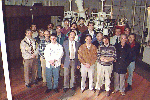


February 12, 1998 marked the 100th anniversary of the first observation made with the 6-inch transit circle. In celebration of this event, group pictures were taken of the members of the Astrometry Department who were available in Washington on that day.